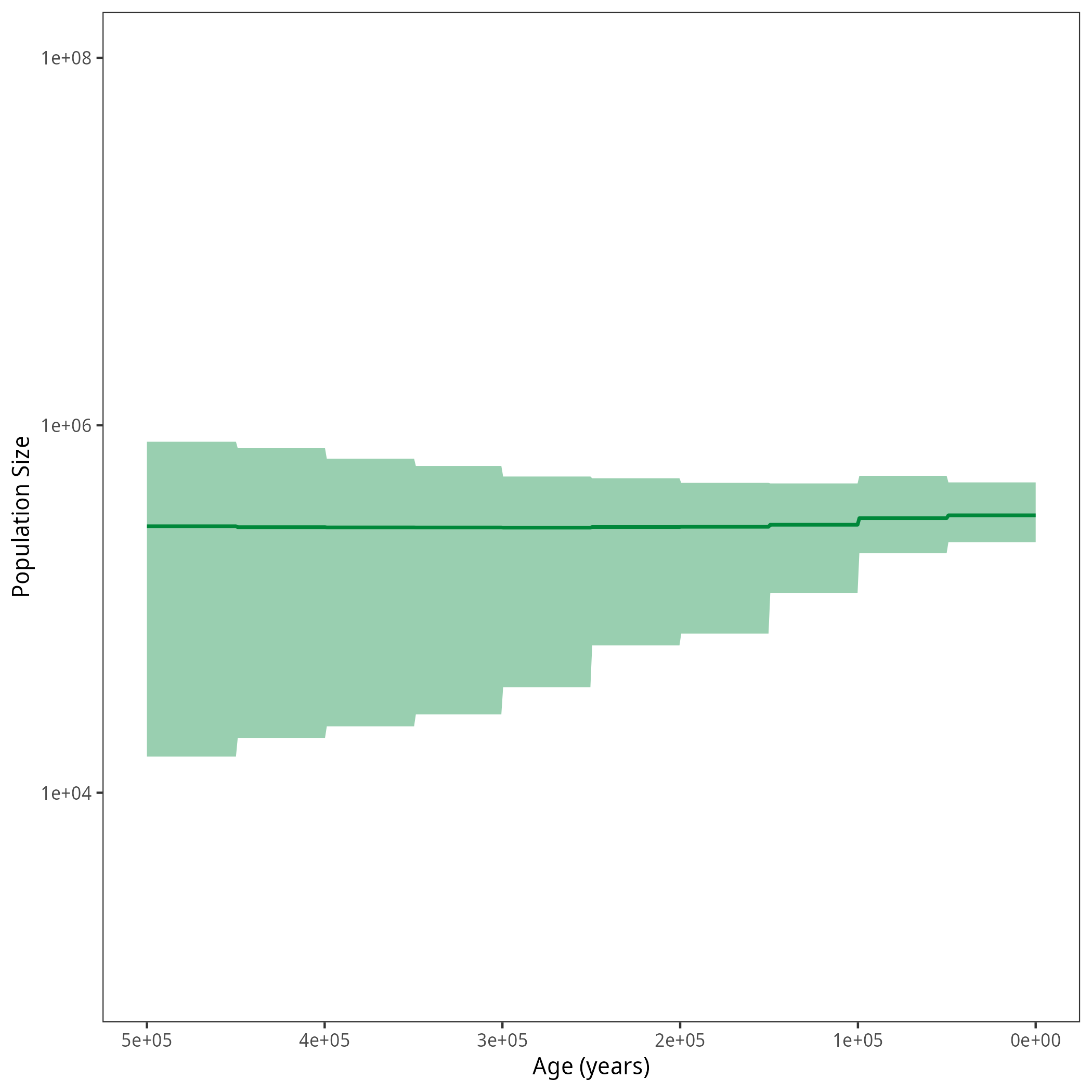Overview
This tutorial describes how to run the Coalescent Skyline Analysis from trees with a Gaussian Markov Random Field (GMRF) prior in RevBayes.
Here, the trees and population sizes will not be estimated simultaneously, but it is assumed that a single tree or a sample of trees is used as input instead of a sequence alignment.
Inference Example
For your info
The entire process of the GMRF based estimation from trees can be executed by using the mcmc_isochronous_GMRF_treebased.Rev script in the scripts folder. The alternative script mcmc_isochronous_GMRF_maptreebased.Rev provides an example on how to compute a maximum a posteriori (MAP) tree in
RevBayesan run the analysis based on that single tree. You can type the following commands intoRevBayes:source("scripts/mcmc_isochronous_GMRF_treebased.Rev") source("scripts/mcmc_isochronous_GMRF_maptreebased.Rev")We will walk you through the first of the scripts in the following section.
We will mainly highlight the parts of the script that change compared to the other exercises. You can have another look at the other exercises, they are listed under prerequisites on the left.
Read the data
Read in the output from the constant coalescent exercise. If you haven’t done the exercise, please download the file horses_iso_Constant.trees into an “output” folder in your tutorial directory.
# Read in the tree sample
treetrace = readTreeTrace("output/horses_iso_Constant.trees", treetype = "clock", burnin = 0.1)
trees = treetrace.getTrees()
# Get the taxa
taxa <- trees[1].taxa()
# Get the number of taxa. We need these later on.
n_taxa <- taxa.size()
The GMRF Model
In contrast to the GMRF exercise, we do not set the maximal age, but take the maximal root age of all trees included in the sample.
MAX_AGE <- 0
for (T in trees) {
MAX_AGE <- max( [MAX_AGE,T.rootAge()] )
}
The remaining part of the model is the same as in the GMRF exercise.
The Tree
Now, we will instantiate the stochastic node for the tree.
Similar to the skyline exercise, we use the dnCoalescentSkyline distribution for the tree.
In the GMRF case, however, the method is not based on events, but has specified intervals.
Also, with having a sample of trees, we use this distribution as prior and need to clamp the tree sample.
tree_prior = dnCoalescentSkyline(theta=population_size, times=changePoints, method="specified", taxa=taxa)
psi ~ dnEmpiricalSample( tree_prior)
psi.clamp(trees)
The interval times are the defined change-points. If you would like to read them out later, you can set them here.
interval_times := changePoints
Again, we constrain the root age as before and add the same moves for the tree.
Working with one tree as input
As mentioned above, you can also have a single tree as input. In this case, you can read it in with
readTrees. Here, we first generate the maximum a posteriori (MAP) tree from the tree sample.trees = readTreeTrace("output/horses_iso_Constant.trees", treetype = "clock", burnin = 0.1) maptree = mapTree(trace=trees, conditionalAges=TRUE) taxa <- maptree.taxa()The remaining part of the script is similar to having a tree sample. The node for the tree is just a little simpler:
psi ~ dnCoalescentSkyline(theta=population_size, times=changePoints, method="specified", taxa=taxa) psi.clamp(maptree)
Finalize and run the analysis
In the end, we need to wrap our model as before.
Finally, we add the monitors and then run the MCMC. Remember to change the file names to avoid overwriting your previous results.
monitors.append( mnModel(filename="output/horses_iso_GMRF_treebased.log",printgen=THINNING) )
monitors.append( mnFile(filename="output/horses_iso_GMRF_treebased_NEs.log",population_size,printgen=THINNING) )
monitors.append( mnFile(filename="output/horses_iso_GMRF_treebased_times.log",interval_times,printgen=THINNING) )
monitors.append( mnScreen(population_size, printgen=100) )
mymcmc = mcmc(mymodel, monitors, moves)
mymcmc.burnin(NUM_MCMC_ITERATIONS*0.1,100)
mymcmc.run(NUM_MCMC_ITERATIONS, tuning = 100)
Results
After running your analysis, you can plot the results using the R package RevGadgets.
library(RevGadgets)
burnin = 0.1
probs = c(0.025, 0.975)
summary = "median"
num_grid_points = 500
max_age_iso = 5e5
min_age = 0
spacing = "equal"
population_size_log = "output/horses_iso_GMRF_treebased_NEs.log"
interval_change_points_log = "output/horses_iso_GMRF_treebased_times.log"
df <- processPopSizes(population_size_log, interval_change_points_log, burnin = burnin, probs = probs, summary = summary, num_grid_points = num_grid_points, max_age = max_age_iso, min_age = min_age, spacing = spacing)
p <- plotPopSizes(df) + ggplot2::coord_cartesian(ylim = c(1e3, 1e8))
ggplot2::ggsave("figures/horses_iso_GMRF_treebased.png", p)

Next Exercise
When you are done, have a look at the next exercise.